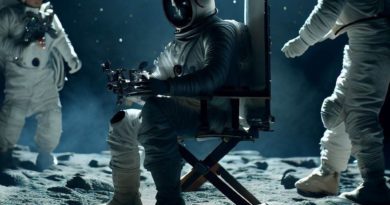To the moon and beyond 2: how humanity reacted to the moon landing and why it led to conspiracy theories
In the second episode of The Conversation’s To the moon and beyond podcast series, we take a look at the impact going to the moon had on humanity – and why it generated so many conspiracy theories.
While an estimated half a billion people tuned in to watch the moon landings on television in late July 1969, what about those who didn’t have access to one? We hear from Keith Gottschalk, a political scientist at the University of the Western Cape, who explains what it was like to learn about the moon landings in apartheid South Africa – one of the few countries in the world where people couldn’t watch the moon landings.
The apartheid regime banned TV so we would have seen the newspaper posters tied up to all the lampposts on the road and the SABC radio (South African Broadcasting Corporation) – in those days the apartheid regime banned all radios except the SABC – would have broadcast extracts.
Gottschalk also explains how the news that the US had beaten the Soviet Union to the lunar surface was met in a country where Cold War rivalry was central to politics and foreign affairs.
We also hear from Alice Gorman, senior lecturer in archaeology and space studies, at Flinders University in Australia. She studies the heritage of what’s been left by humans on the moon’s surface and what it means for people back on Earth. She laments what was lost when astronauts stopped going to the moon in 1972.
We lost a tradition. We lost the continuity of technologies and cultures that enable people to survive on other planets. So now we’re kind of reinventing those again.
Gorman tells us why she thinks the Apollo 11 sites could become heritage sites for future generations of visitors to the moon. To find out more about her work as a space archaeologist, researching the various debris that humans have left in space, you can also read a write-up of Gorman’s interview with Conversation science editor Sarah Keenihan here.

MORE ON THE MOON AND BEYOND
One of the enduring legacies of the moon landings has been the conspiracy theories it generated, which claim that the Apollo missions were all a hoax orchestrated by the US government. Peter Knight, a professor of American studies and an expert in conspiracy theories at the University of Manchester in the UK, explains the cultural moment in which these sprang up in the mid 1970s.
The immediate context that we need to think about is the Vietnam War and a sense of disillusionment with the official version of events and, in effect, the lies that Americans felt their government had been telling them.
Knight also tells us how, in many parts of the world, a large number of people still believe that the moon landings were a hoax – ranging from between 5-10% of Americans and 12% of Britons, to 20% of Italians and 57% of Russians.
But what can be done about it? We hear from Viren Swami, a professor of social psychology at Anglia Ruskin University in the UK and Centre for Psychological Medicine at Pedana University in Malaysia, who has carried out psychological experiments testing belief in moon landing conspiracy theories. He explains some of his findings:
When you already believe in a conspiracy or a conspiratorial world view – when you see patterns in data that make you believe that there are conspiracies in the world – you’re more likely to adopt different conspiracy theories. Even if they are sometimes contradictory, or even if they don’t make sense.
Swami also explains how promoting analytical thinking can help reduce belief in conspiracy theories.
To the moon and beyond is a global collaboration between different editions of The Conversation around the world, hosted by Miriam Frankel and Martin Archer. You can listen via The Conversation, or subscribe wherever you get your podcasts by hitting the “Listen and Subscribe” button at the top of this page.
Credits:
To the moon and beyond is produced by Gemma Ware and Annabel Bligh. Reporting by Nontobeko Mtshali, Sarah Keenihan and Johnathan Gang. Sound editing by Siva Thangarajah. Thank you to City, University of London’s Department of Journalism for letting us use their studios.
Picture source: Jack Weir via Wikimedia Commons.
Music via Free Music Archive:
Even when we fall and Western Shores by Philipp Weigl
Tapoco and Bedroll by Blue Dot Sessions
Hallon by Christian Bjoerklund
As time passes marimba, Zapslat
Archive footage:
Apollo 11, 13 and 17 audio from NASA
*** This article has been archived for your research. The original version from The Conversation AU can be found here ***


